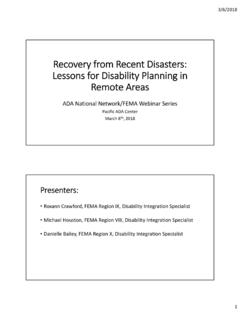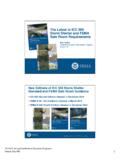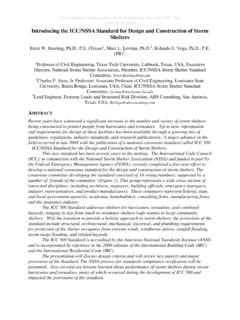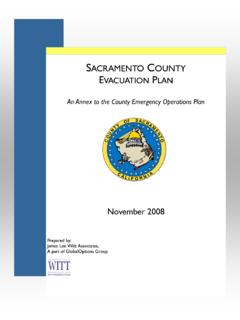Transcription of Accessible Means of Egress/Emergency Evacuation
1 Accessible Means of Egress/Emergency Evacuation Presenter: Kimberly Paarlberg, RA International Code Council Agenda What is the International Building Code (IBC)? Types of disasters to addressed in IBC emergency Evacuation from a fire Planning Notification & Communication Means of egress (MOE) Accessible Means of egress (AMOE) New Technology 2 What are the International Codes? The International Building Code (IBC) is a model building code developed by the International Code Council (ICC). The ICC has a family of codes providing minimum requirements for public health and safety. It has been adopted throughout most of the United States at the state or local level as a referenced document. States do make amendments. Published every 3 years so that requirements stay current with industry advances.
2 3 What are the International Codes? The IBC addresses construction and design or new buildings and alterations. The IFC code addresses the operation of a completed building. For example, the building code sets criteria for the number, size and location of exits in the design of a building while the fire code requires the exits of a completed building to not be blocked. The building code also deals with access for persons with disabilities both in and out. 4 Enforcement The architect, contractor and building owner are required to comply with federal and state regulations. The building code official and fire official enforce state/local laws. These laws reference the IBC for minimum building requirements. The building code official does not enforce federal laws, including the ADA. 5 Means of egress Refers to the ability to exit the structure, primarily in the event of an emergency , such as a fire.
3 A Means of egress is broken into three parts: the path of travel to an exit, the exit itself, and the path to a safe area outside. 6 Means of egress Requirements are based on: The number of exits required for a structure based on its intended use and the number of people who could be in the place at one time as well as their relative locations. Special needs, such as hospitals, nursing homes, and prisons where evacuating people may have special requirements. Possible hazards (such as in industries) where flammable or toxic chemicals will be in use. 7 ADA & ABA Standards 207 Require compliance with the International Building Code (IBC) for Accessible Means of egress 8 OR IBC 2003 Section 1007 IBC 2000 with 2001 Supplement Section ADA & ABA Standards What about compliance with later editions?
4 Permitted where equivalent or better ( equivalent facilitation in the ADA Standards Section 103) 9 2015 Are you or your community prepared for this? Types of hazards Fire Earthquake Wildfires Severe weather Snow/Ice Flood/Storm Surge Tornado/Hurricane/High Winds 11 Prepare Yourself and Your Family Although no one can prevent disasters from occurring, there are many things you can do to make the impact less devastating for your family. Every home should have 3 key elements in place before a disaster strikes: Evacuation Plan Communication Plan emergency Supply Kit 12 Wildfires 13 Wildfire Potential 14 In Wildfire Areas ICC s International Wildland-Urban Interface Code contains detailed requirements to minimize the hazards. Fire service access; premises identification; access to water and equipment.
5 15 In Wildfire Areas What you can do Plant fire prone trees and shrubs away from your home and far enough apart so they won t ignite one another. Install noncombustible 1/4 inch or smaller mesh screening on attic/soffit vents and around elevated wood decks to keep out embers. Maintain a defensible space around your home by clearing all flammable vegetation a minimum of 30 feet around all structures. Consider installing protective shutters or heavy fire-resistant drapes. 16 Earthquakes 17 Earthquakes 18 In Earthquake Areas The IBC contains requirements for earthquake design Seismic resistance systems to improve building resistance to earthquakes Reduce the risk or life loss or injury of occupants 19 In Earthquake Areas What you can do Make sure your home is securely anchored to its foundation Strap water heaters, appliances and TVs to wall studs.
6 Anchor bookshelves, heavy furniture, appliances and televisions to wall studs. Secure pictures, mirrors and ornaments to the wall with appropriate fasteners. Know where and how to shut off electricity, gas, and water services. 20 Floods/Storm Surge 21 Floods/Storm Surge 22 In Flood/Storm Surge Areas 23 The IBC contains requirements for building in flood and coastal areas. This is in cooperation with FEMA and the NFIP. Elevating your home above the base flood elevation (the elevation associated with the "100-year flood") is the best method of protecting your home, and is a requirement for new homes. In Flood/Storm Surge Areas 24 What you can do Don t wait evacuate! Elevate mechanical equipment such as water heaters, furnaces, air conditioner units, circuit breaker boxes. Anchor propane tanks.
7 Know where gas and water shutoffs are located. Tsunami Appendix M Tsunami-Generated Flood Hazard. Addressing a tsunami risk for all types of construction in a tsunami hazard zone through building code requirements would typically not be cost effective, making tsunami-resistant construction impractical at an individual building level. The appendix does allow the adoption and enforcement of requirements for tsunami hazard zones that regulate the presence of high risk or high hazard structures. 25 Volcanoes 26 Not in the codes now. Community planning similar to tsunamis? High winds 27 High Winds The IBC has requirements for high wind and weather protection. The requirements for high winds are not enough to protect your home or business from a tornado or hurricane. 28 High Winds What you can do Install permanent shutters, or plan to protect your windows and glass doors with plywood panels.
8 The roof of your house is very vulnerable to high winds. Reinforce the connection between the roof and walls with hurricane straps and bracing to resist uplift. Reinforce double-entry front doors as well as garage doors. Clear away dead or weak tree branches that may break off and damage your house in high winds. 29 Tornadoes and Hurricanes 30 Wind loads Wind load contour maps Hurricanes Atlantic coast and Gulf of Mexico Hawaii, Puerto Rico, Guam and Virgin Islands Tornado Mid-west and eastern states Alaska, American Samoa, Guam, Hawaii, Puerto Rice, Virgin Islands 31 Types of shelters Shelters used for hurricanes Shelters used for tornadoes The primary difference in these two types is the expected duration of the storm. Hurricane shelters 24 hours Tornado shelters 2 hours 32 Types of shelters Community shelters Any shelter that is not a residential shelter Residential shelters Limited to 16 occupants maximum Limited to a residence or small group of residences ICC/NSSA 500 Standard for the Design and Construction of Storm Shelters 33 Fires 34 Fire Protection 35 The IBC contains requirements for fire rated construction, sprinklers, alarms and smoke detectors.
9 What you can do Replace batteries in smoke detectors Have a fire Evacuation plan at work and at home and practice it. Participate in the planning for fire and safety Evacuation plans. In case of fire United Spinal resource - Prepare yourself Participate in the planning where you live and work 36 Planning 38 Pre-Planning for Emergencies Fire Evacuation plans Fire safety plans Lockdown plans Associated drills Worked out with the building owner/renter and the fire department Updated annually or when necessitated by changes Available for review 39 Pre-Planning for Emergencies Required in: Assembly Churches over 2,000 occupants Educational College dormitories High Hazard Institutional Hotels Group homes 40 Pre-Planning for Emergencies Required in: High-rise buildings Covered malls > 50,000 Mercantile & Factory (> 500 occupants on the 1st floor and basements or 2nd floor > 100 occupants)
10 Underground buildings Assembly, Educational and Mercantile with atriums 41 Fire Evacuation Plans emergency routes Strategy - Evacuation or defend in place Critical equipment operation Assisted rescue procedures Verifying full Evacuation emergency responders Notification of occupants Notification of fire department emergency voice/alarm communication system 42 Fire Safety Plans Reporting emergency Evacuation or relocation of occupants Site plans occupancy assembly point, fire hydrants, fire truck route Floor plans exits, routes, areas of refuge, fire alarm, extinguishers, fire hoses Major fire hazards Persons responsible 43 Lock-down plans Occupant notification emergency responders notification Accountability Recall Communication Coordination Training 44 emergency Drills Assembly quarterly Business annually Educational monthly Factory annually Institutional quarterly on each shift Hotel - quarterly on each shift Apartments/dorms 4 times annually Group homes - quarterly on each shift High rise - annually Notification& Communication 45 Signage Evacuation plans at elevators Signage at any non- Accessible exits 46 Signage Visual exit signs at stairway entrances Tactile exit signs at stairway entrances 47 Signage Visual signage within the stairway Tactile signage indicating floor levels Tactile signage at the door leading to the






